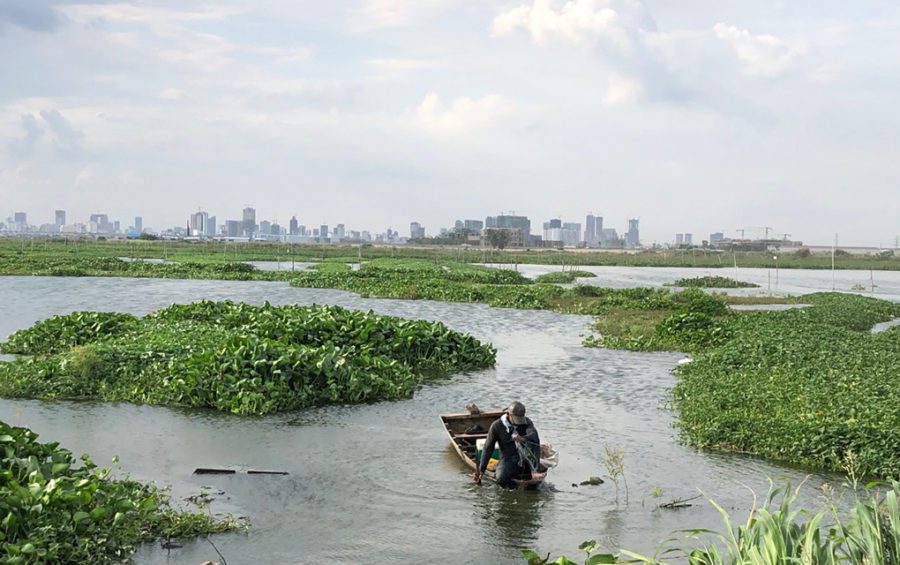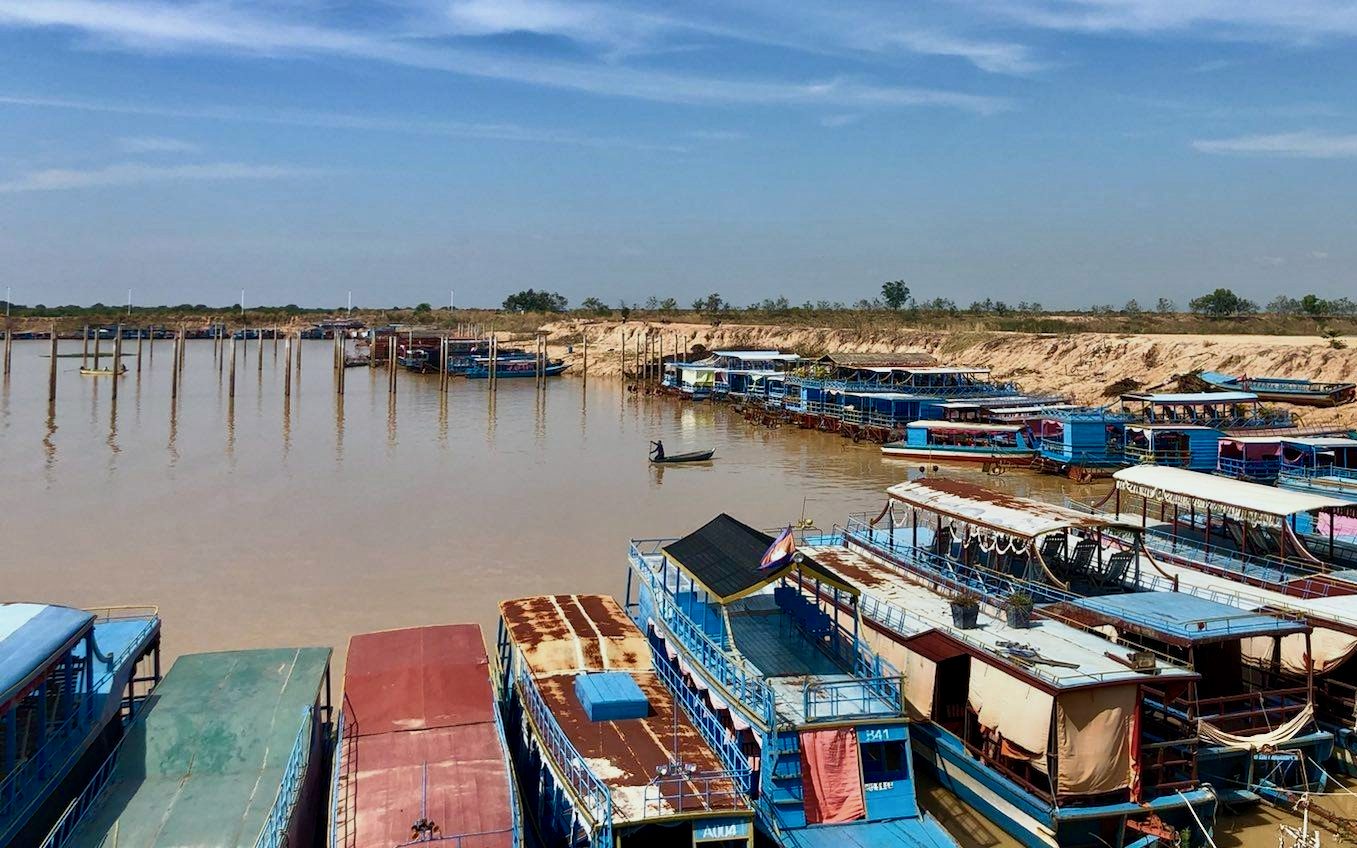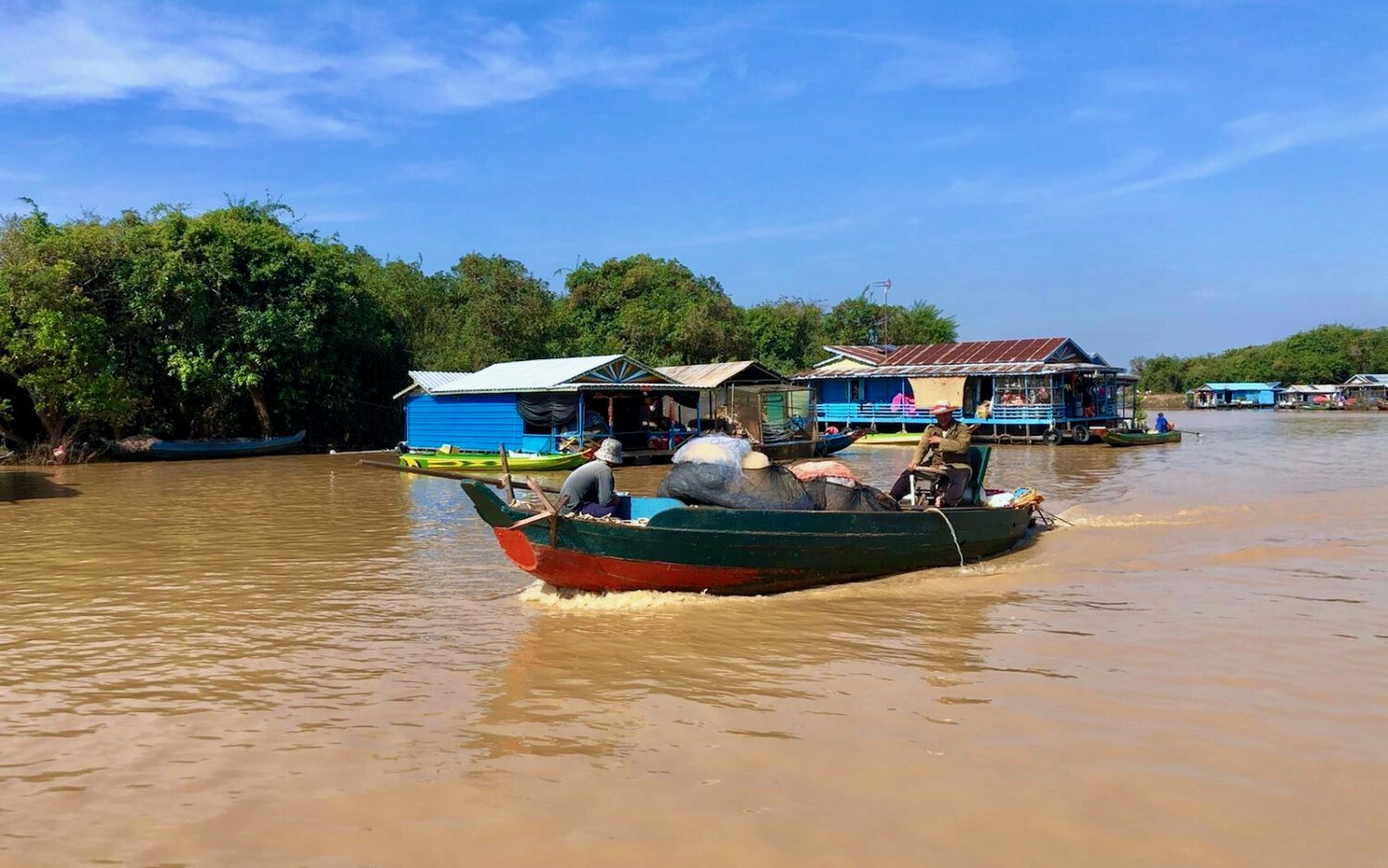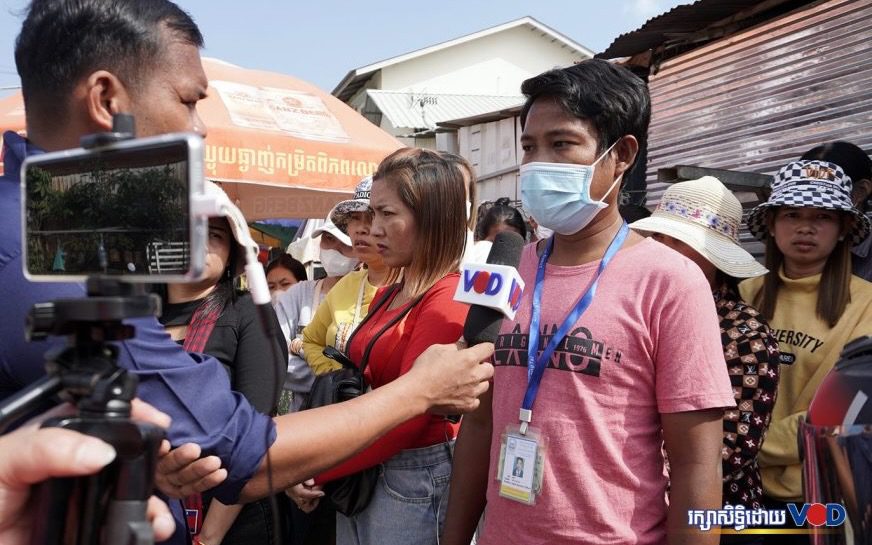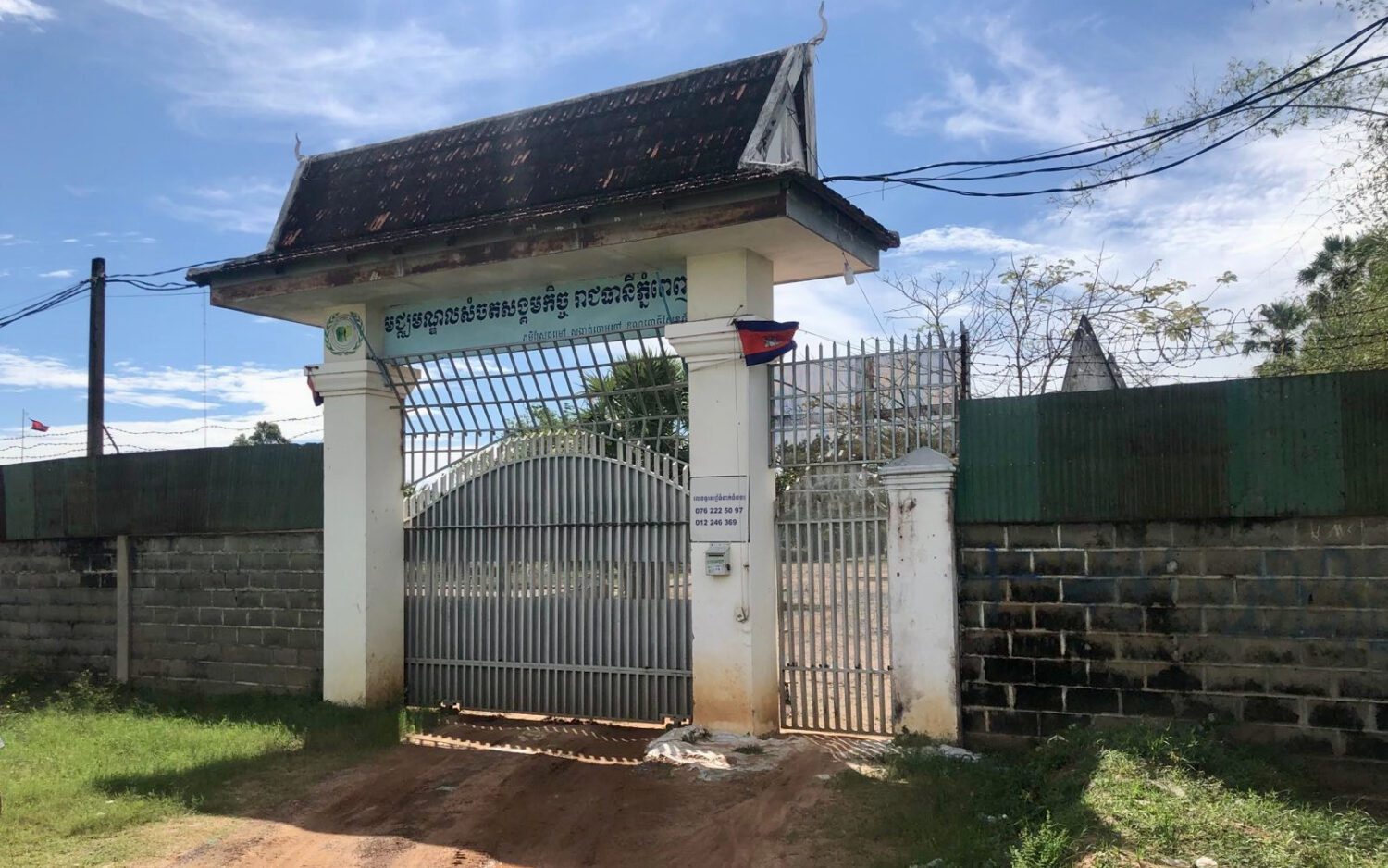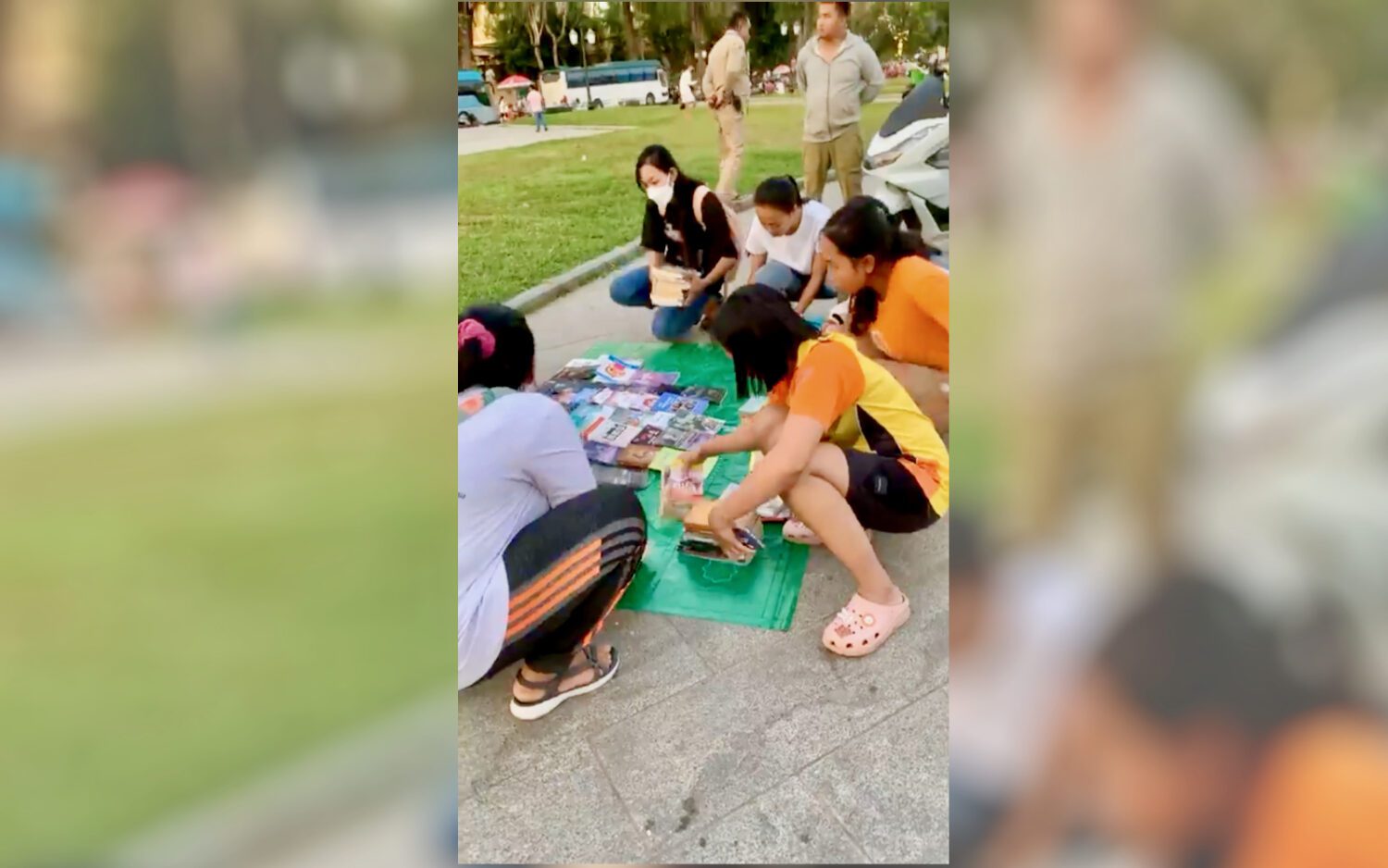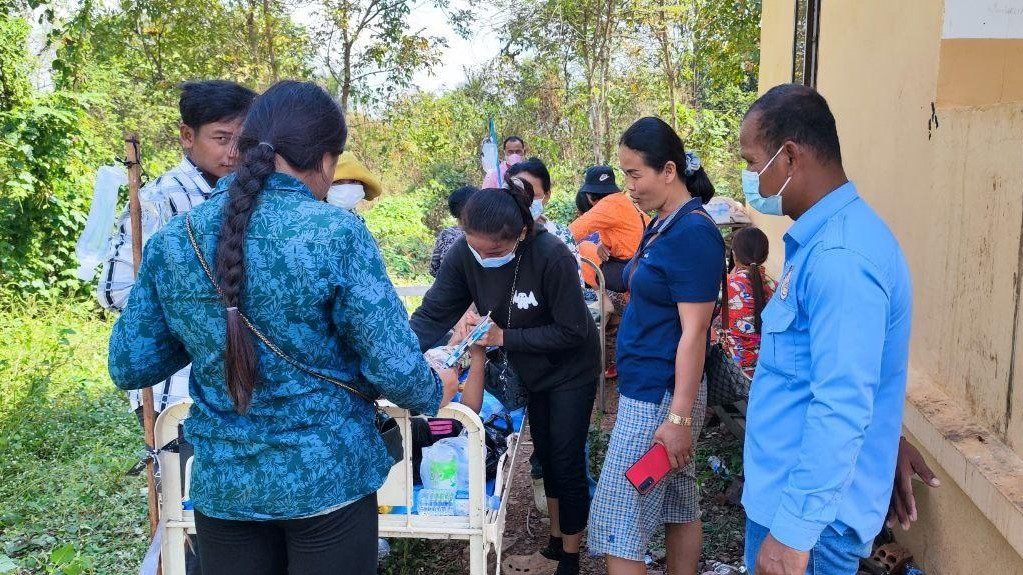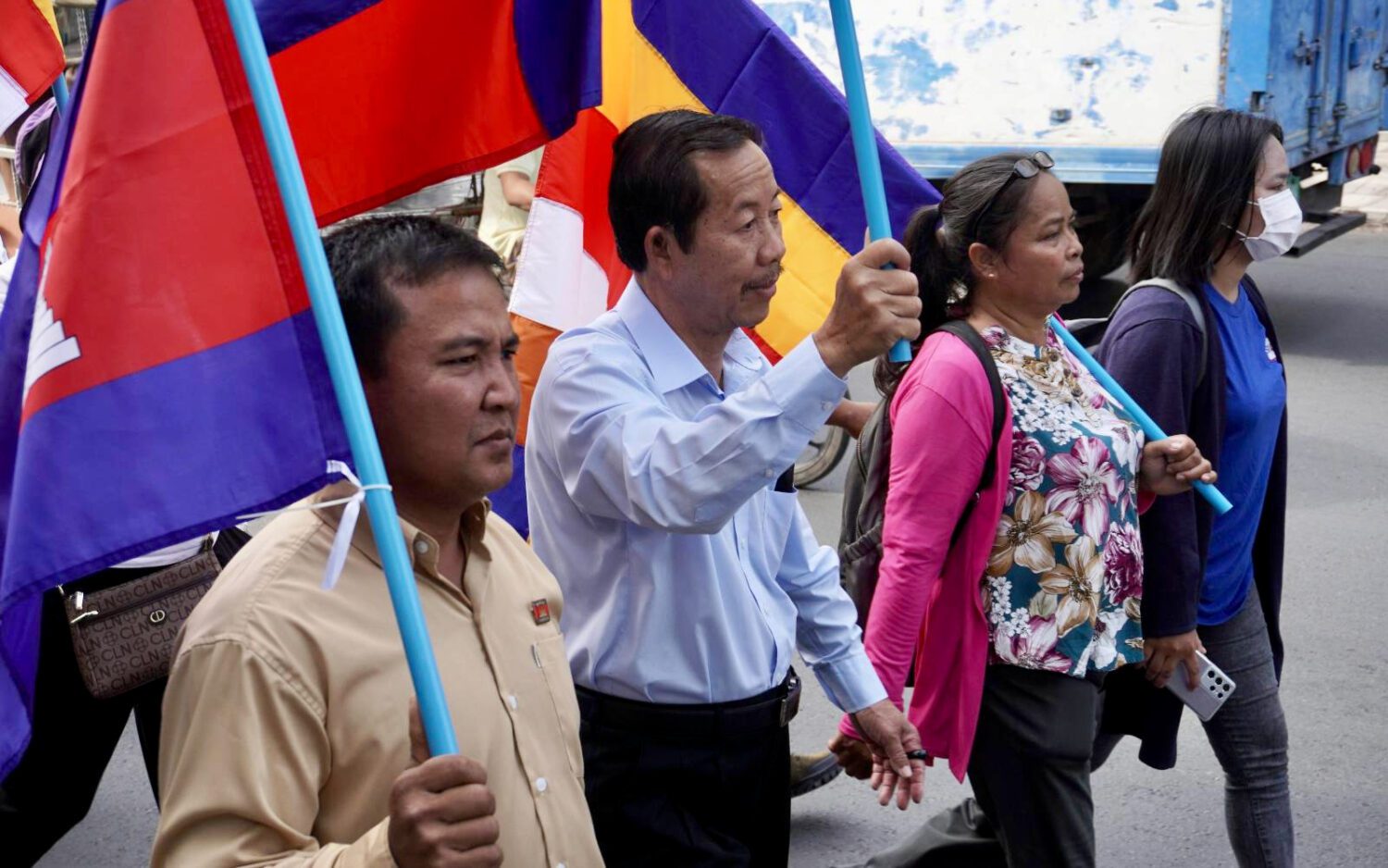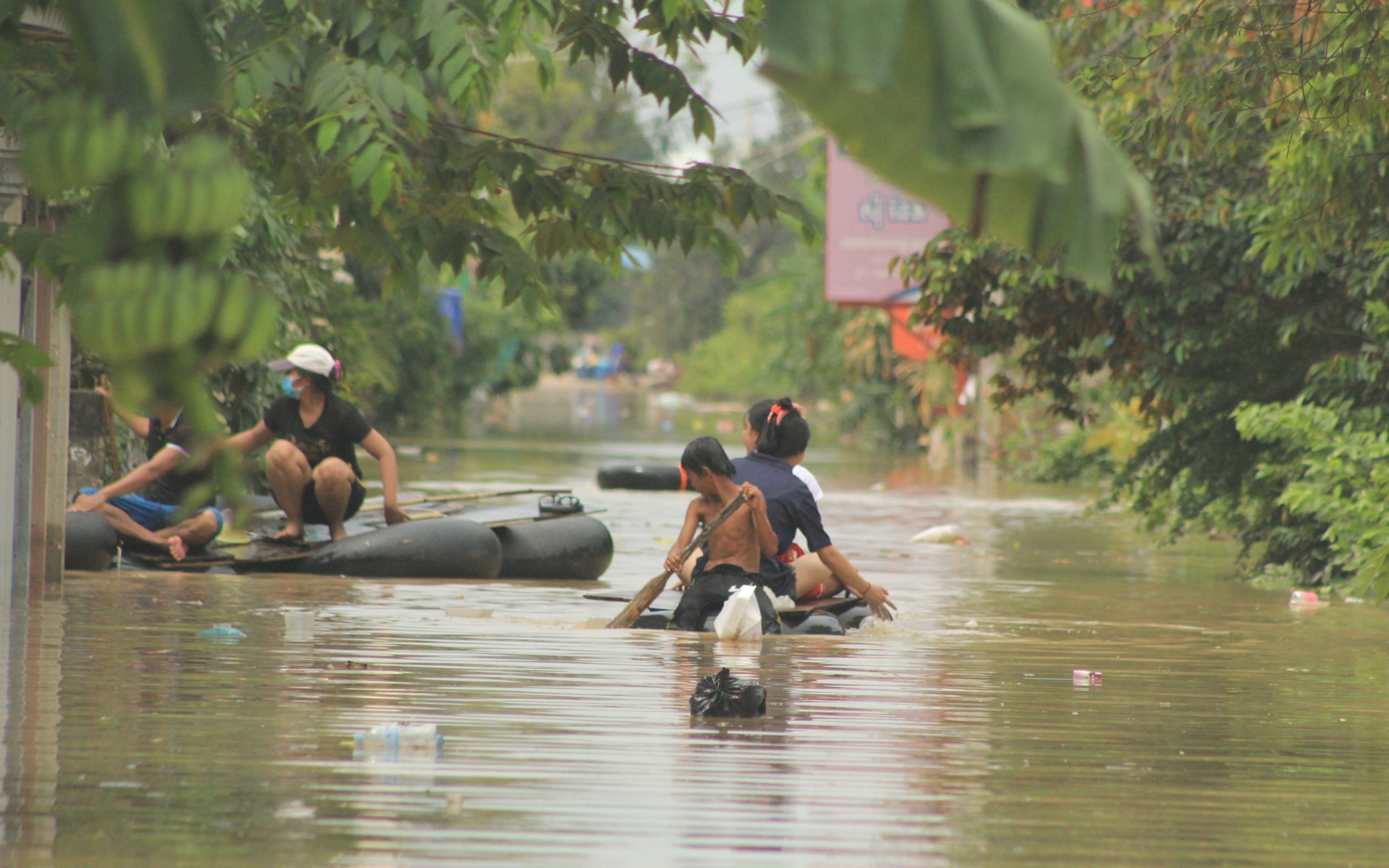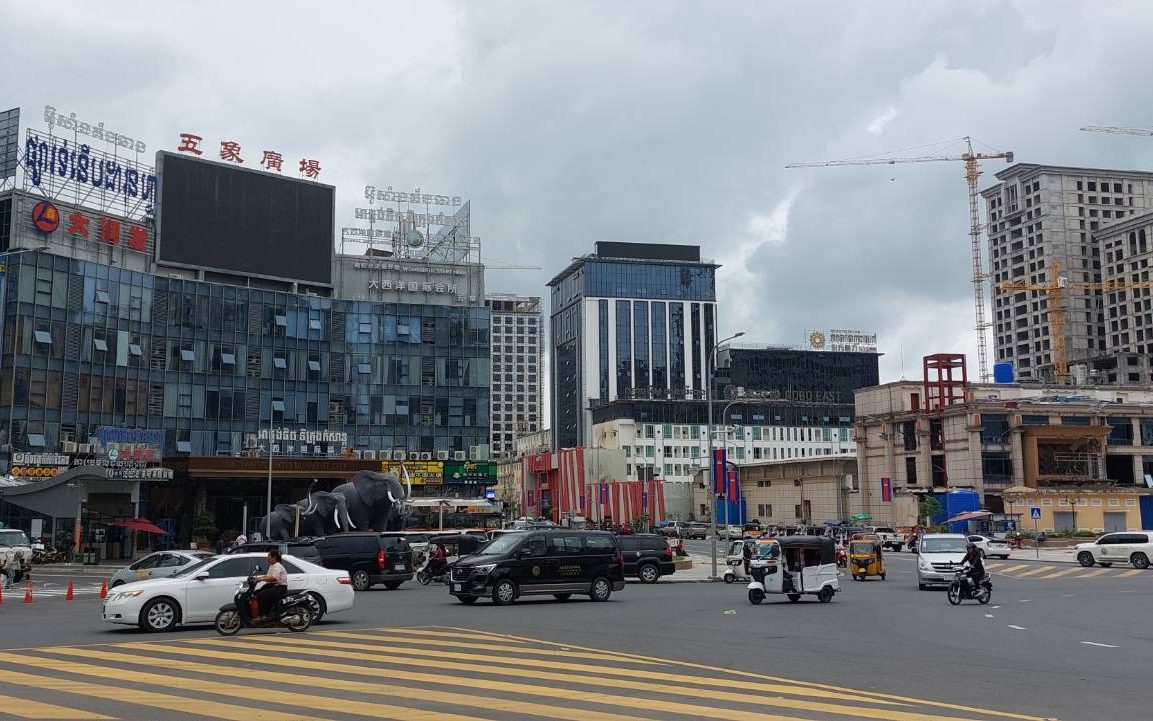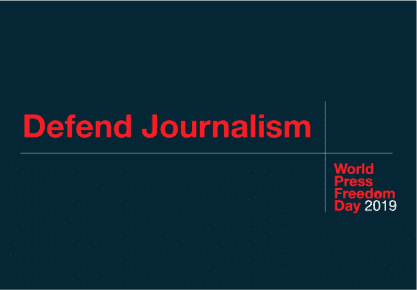Thoeung Theng and his wife have made a living from the fish and plants of the Tompun Lake in southern Phnom Penh for more than a decade. But after people started advising him earlier this year to leave the lake as soon as he can, Theng is considering what he can do outside the localized lake economy to support his family.
“Look! The lake is filled and now I can only see condos and big buildings. I won’t be able to fish anymore,” Theng said, as he examined a recent catch.
The handful of fish in his bucket was a much smaller haul than what he could catch before, and he only expected conditions on the lake to get worse.
“These days on this lake, it is so fresh. If these condos are built, polluted air won’t be able to go anywhere, it will just stay here,” Theng said. “First, the sewage water filled with chemical substances won’t go anywhere. Secondly, if we have more condos, we won’t have fresh air, and the polluted air will make people sick. Some sick people can’t afford medicines; they will just wait to die.”
In the name of urban development, powerful individuals and major companies are filling in the lakes in Phnom Penh’s north and south at the expense of lake residents. While government officials have been quick to wave away environmental concerns, current residents and advocates warn that continued lake-filling will cause irrevocable damage to livelihoods as well as the capital’s ability to deal with wastewater.
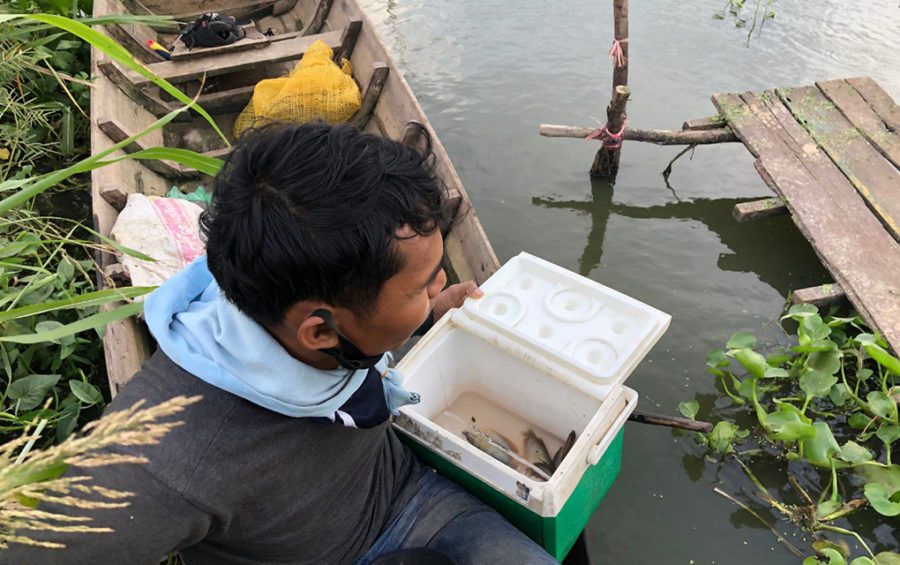
In a new report released on Monday, four human rights and urban land rights organizations warn that more than 90 percent of the wetlands in Phnom Penh’s Meanchey district will be filled if development continues as slated. Development projects threaten the livelihoods and homes of more than 1,000 families who live and work on the wetlands, and may unleash serious environmental consequences on the city’s landscape, the report says.
More than 1 million people are at increased risk of flooding and worsening food insecurity, it adds.
The Boeng Tompun and Choeng Ek wetlands in the base of the city stretch across 1,500 hectares. The area was granted in 2004 to ING Holdings, which is directed by tycoons Ing Bun Hoaw, Lim Bunsour and Lim Rose, and includes prominent developments such as Aeon Mall, Chip Mong Land villas and mall, and Urban Village condominiums.
Citing various sub-decrees from 2017 and 2018 that endowed land to private individuals and companies, the rights groups’ report, titled “Smoke on the Water,” says 14 development projects slated for the area will leave “a small river,” just 107 hectares of wetlands, untouched. According to satellite imagery of the area, a third of the wetlands have already been filled in, leaving only 1,000 hectares of undeveloped land to date.
Aside from displacing residents, farmers and fishers who have occupied the area for decades, the report notes that the wetlands serve as the drainage point for about 70 percent of the capital’s rain and wastewater, with water-dwelling plants serving as a “semi-effective” treatment of contaminated water.
A previous study commissioned by Phnom Penh City Hall says at least 480 hectares of the wetlands would need to be preserved in order to prevent flood and wastewater issues, or some 25 to 30 million cubic meters of water annually would need to be managed by other means, potentially increasing flooding in low-lying parts of Phnom Penh and Takhmao City.
Changing Lifestyles on the Lake
Soeung Saran, executive director of urban land rights group Sahmakum Teang Tnaut (STT), which co-produced the report, said lake-filling has negative impacts on citizens, cutting their incomes from farming and fishing, and raising the possibility of home eviction. This kind of development doesn’t help the lake’s current residents but instead benefits private companies and the wealthy individuals who own or work for them, Saran said.
“Only those who have high incomes can afford to buy property from those development projects because the prices are expensive,” he said. “Those lakes are located in the middle of the city, which is why the projects are expensive too.”
In a survey conducted for the “Smoke on the Water” report, 62 percent of 469 respondent households in Tompun and Choeng Ek said they were in debt, with a little more than half of the indebted respondents saying they were able to repay their loans on time.
Yann Chantha, a fisher who was fixing his boat on the banks of Tompun Lake after farming vegetables, said he and his wife can earn just about 100,000 riel ($25) per day because their aquatic crops and fish catches yield less than in the last three years. The 31-year-old said about 30 or 40 percent of his neighbors are now taking construction jobs due to the reduced amount of fish, but he’s avoiding doing so for now.
“We cannot earn much these days due to the filled-in lake. We could find some [fish] from that spot [in the lake]; some from another spot. We go to many spots in this lake but we can find so little,” he said. “For me, I have no idea what I am going to do next. We’ll see when the time comes.”
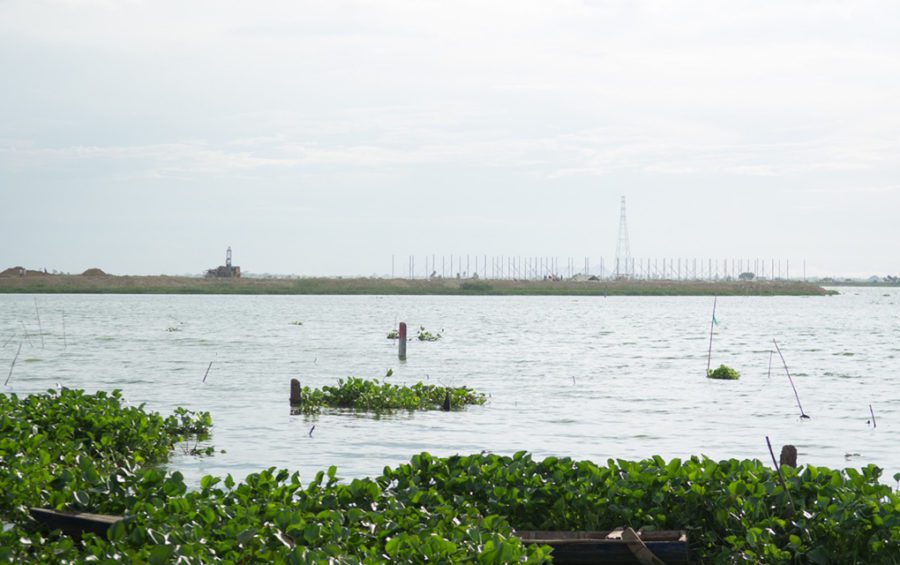
According to the report, the filling in of the wetlands will affect not only locals’ lives and rights, but also endangered fish and birds, and the environment. The report says farmers are reporting smaller fish catches and struggling to find some of the 52 species of fish that live in the wetlands. In addition, the report estimates that infilling the wetlands will require 77 million cubic meters of sand, fulfilled by dredging the Mekong and Bassac rivers. However, sand dredging has serious environmental consequences, and has been linked to riverbank collapse, increased flood risk, death of fish, habitat loss and consequences for the groundwater table.
Long Kunthea, an environmental activist with Mother Nature Cambodia, said the loss of lakes in the southern and northern ends of the capital was impacting both citizens and the biodiversity that depend on the lakes’ resources. The negative effects would only increase in the rainy season, she said.
“When lakes are filled and when it rains, Phnom Penh floods everywhere,” she said. “The citizens whose lives depend on the lake resources will lose their places, some of whom cannot afford to find new shelters.” She added that lakes are the state’s public property; however, most filled-in lakes only benefit the rich.
Filling in the North
Developers are increasingly filling lakes to build satellite cities, boreys and condominium developments on the capital’s borders.
Since 1990, 16 of Phnom Penh’s 26 lakes have been filled while the other 10 have been partially filled, STT said in a separate report last year. There are only two lakes of the 26 that have seen minor infilling so far — Tamok and Samrong — according to the December report from STT. However, developers are now eyeing Tamok.
About 30 kilometers from the city center, Tamok lake, also known as Tumnup Kabsrov, is the capital’s biggest lake, occupying 3,240 hectares in the north.
But northern Phnom Penh has become a center of new developments, and more than 500 hectares of Tamok have been cut out and allocated to various state and private development projects since 2018.
Last month, Prime Minister Hun Sen signed a sub-decree granting nearly 300 hectares of reclaimed land from the lake to the Defense Ministry, in order to build a Royal Cambodian Armed Forces long-term strategic command base.
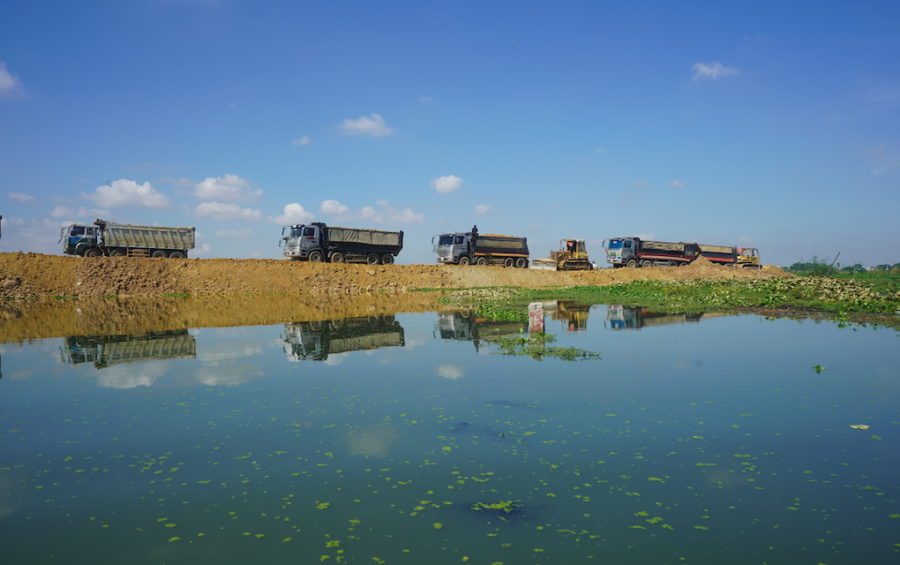
In another sub-decree dated April 27, 30 hectares were given to Kim Heang, the wife of tycoon and ruling CPP senator Ly Yong Phat in exchange for 9.8 hectares of Phnom Penh land. Heang is also chair of Hero King Ltd., which the rights groups’ report says is one of the firms involved in providing sand for infilling.
On June 22, the same day nearly 300 hectares of Tamok lake was allocated to the Defense Ministry, lake residents protested at Prek Pnov District Hall.
“If we don’t have shelter, we are worse than animals,” Prak Sophea told a group of Tamok community women who gathered two days after they had protested together.
Sophea’s family and some 96 others have been living along Tamok lake since 1990. The group started meeting and protesting in an effort to protect their houses and jobs that depend on the lake.
“This [lake-filling] affects me and my community the most,” she said. “Our lives depend on this lake.”
Im Phalla, a 70-year-old resident who has joined the community meetings, said residents of Tamok had struggled to support their families even before new developments threatened their floating neighborhood. Now, Phalla said life has become harder as their daily activities were closely watched by authorities.
“Even when I ask to repair my broken bathroom and walls, I am not even allowed to do [that],” she said, noting that local authorities have prevented her from making home repairs.
‘Develop Some and Keep Some’
Sarin Vanna, director of Phnom Penh municipal land management, urban planning and construction, rejected the idea that lakes in the capital were being filled in, even after hearing accounts witnessed by residents and VOD. Instead, he claimed the lakes were actually being cleaned to store flooded water when it rains, and said local residents were occupying lake space they did not own.
“There is no case of lake filling. There are only cases of people grabbing the lake,” he said. “In Phnom Penh, it is like the bottom of a pan. We need to extract the sewage water to Tompun station through Trabek lake and [Tamok] lake. We are collecting information on these lakes.”
The one project for which he admitted some lake-filling had occurred was for the Daemko market relocation, in which the city plans to relocate the busy street market into a reclaimed space on Tamok.
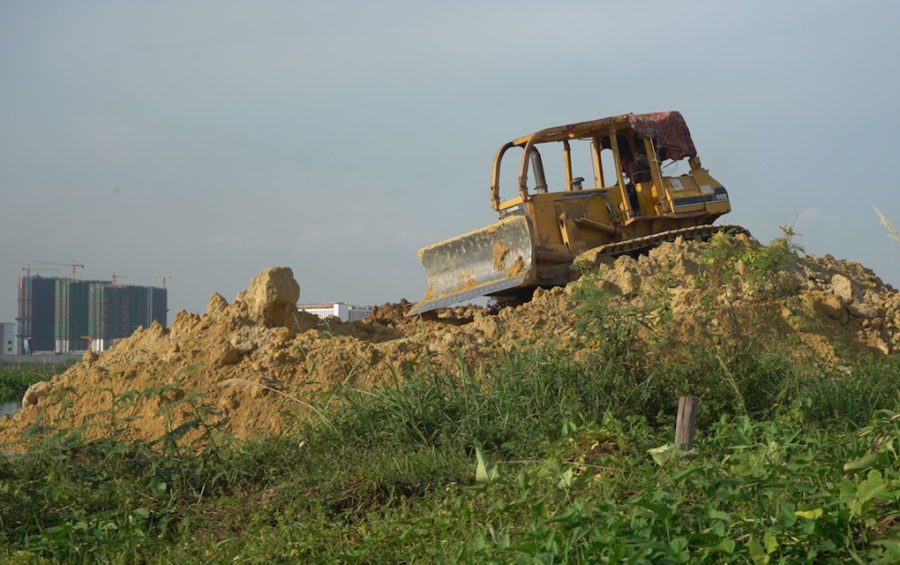
Phnom Penh City Hall spokesperson Met Measpheakdey said filling lakes is a part of urban development, and all development has positive and negative impacts.
“[We] always conduct studies and prepare [the projects] according to our plans,” he said.
Measpheakdey also claimed people who are evicted from lake-filling projects end up having better lives after they are resettled in new areas.
“When we have great development plans, they are able to live in better places that we prepared for them while the old places are developed,” he said. “It is a win-win strategy.”
However, Saran from STT recalled the violent eviction of Phnom Penh’s Boeng Kak community, where the 90-hectare lake was filled and residents were forcibly removed to make way for a vast city development that is still largely unoccupied.
Saran said after the dispute occurred, residents had moved to a place with newly built infrastructure, but they still faced challenges in finding jobs and coping with the new environment into which they unwillingly moved.
Though sand continues to pour into Phnom Penh’s lakes, some still hope the government will preserve some remaining bodies of water.
Sok Touch, president of the Royal Academy of Cambodia, last month called on the government to stop filling lakes, adding that if the practice continued, the city would flood because rain won’t have any place to go. Instead, Touch said lakes and wetlands could be developed as tourist attractions.
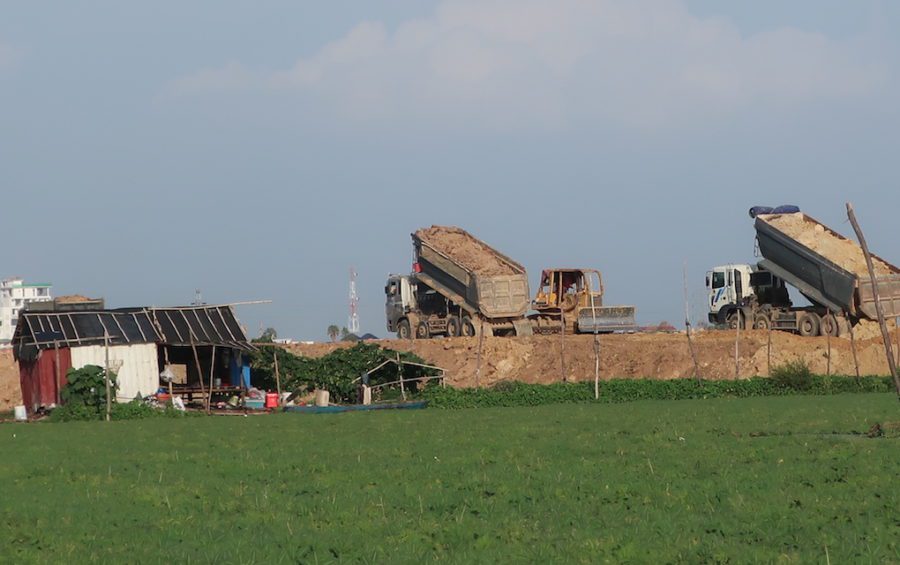
Saber Masoomi, country coordinator at the international conservation group Wildfowl and Wetlands Trust, said the government should create a water security plan to ensure Phnom Penh does not flood, like Bangkok does following its extensive development.
“Phnom Penh is a city that requires a water security plan,” he said. “The water security plan can tell us how freshwater supply in the city is going to happen, how floods are going to be managed and how wastewater is going to be treated.”
Lakes can be preserved as part of the city’s heritage, Masoomi added, noting that the capital’s bodies of water would appeal to foreign tourists as well as provide fresh air and a relaxing environment for local residents.
As for those like Theng, the fisherman, who rely on Phnom Penh’s lakes, they are increasingly troubled by the loss of their homes and livelihoods.
“Develop some and keep some,” Theng said last month as he stared into the lake he calls home. “When [companies] develop like this, the poor will not be able to earn anything. I’d like to ask to keep some [of the lake]. Please keep some for us. When the lake is completely filled, we won’t know where else to go.”


